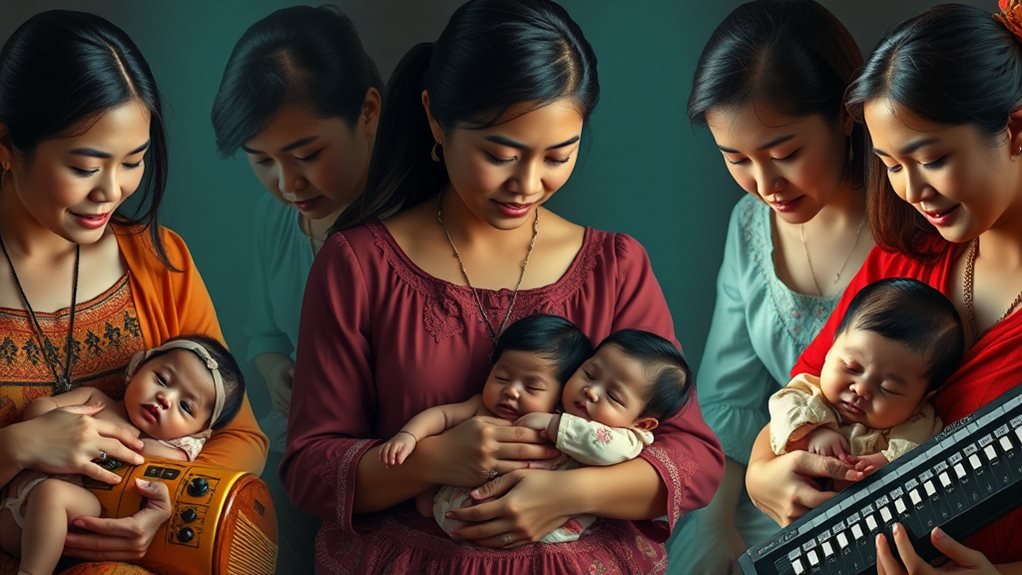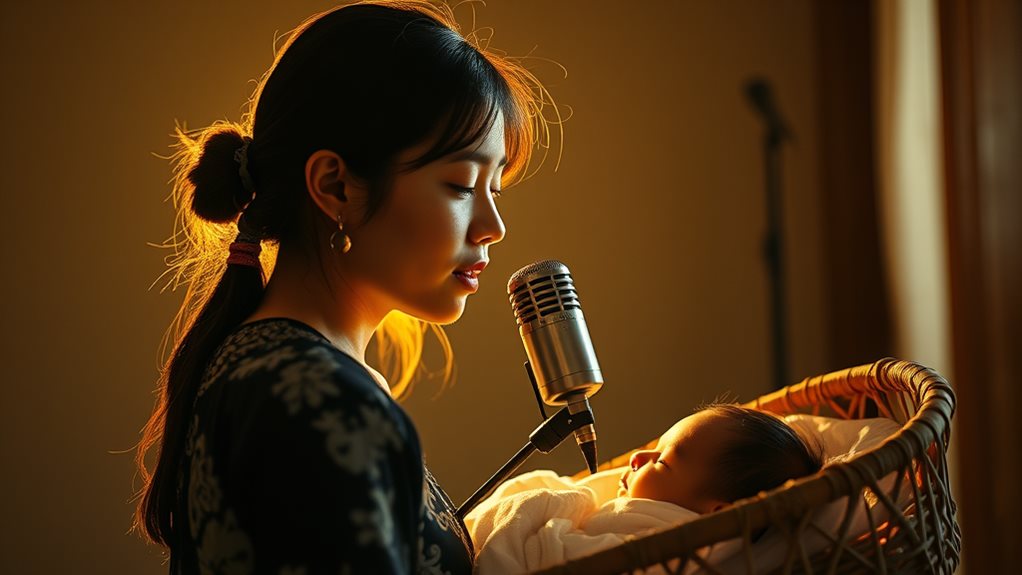Modern interpretations of traditional Filipino lullabies are revitalizing the cultural heritage of the Philippines. These projects reimagine traditional lullabies, known as *hele*, through stunning music videos that blend traditional melodies with contemporary sounds and filmmaking techniques. Collaborations between artists and ethnolinguistic groups** showcase diverse lullabies from various regions, highlighting the country's cultural richness and promoting national identity. These modern interpretations are accessible online, making them easily available for appreciation and cultural education. Significant cultural understanding** is fostered in children, and further exploration reveals a deeper understanding of this initiative's scope and impact.
Project Background and Goals

The CCP's Modern Filipino Lullabies project was launched on November 13, 2022, by board trustee and vice chair Michelle Nikki Junia. This project aimed to reintroduce traditional Philippine lullabies, specifically *hele*, to contemporary audiences.
The project was born out of a recognized scarcity of Filipino lullabies in early childhood music education. This scarcity highlighted the project's cultural relevance, as it sought to nurture a new generation grounded in Philippine song traditions.
The project's musical arrangements were expertly crafted by Krina Cayabyab, based on the research of ethnomusicologist Sol Trinidad. Eight filmmakers from CCP's Cinemalaya contributed to the project by creating music videos, broadening its reach. Experts like Dr. Felicidad Prudente and Benicio Sokkong further enriched the endeavor. Contemporary singers lent their voices, ensuring accessibility for modern listeners.
The project's goals extended beyond mere reintroduction. It aimed to promote musical awareness and its benefits for children's brain development.
It sought to instill a sense of identity in children through these oral traditions, ensuring the cultural relevance of *hele* for future generations. The project aimed to safeguard these traditional songs through documentation and dissemination, making them readily accessible.
It intended to foster broader appreciation for indigenous music and inspire cultural innovation.
Featured Lullabies
The CCP's Modern Filipino Lullabies project features a diverse collection of traditional Filipino lullabies from various regions and cultural groups.
Iconic pieces like "Sa Ugoy ng Duyan" evoke nostalgia for childhood, showcasing the rich cultural heritage of the Tagalog region. This classic lullaby, composed by Lucio San Pedro and Levi Celerio, is a testament to the project's commitment to preserving cultural expressions.
Regional variations are highlighted, such as the Bicolano "Katurog na, Nonoy," which offers unique imagery and showcases the diversity of lullabies across the archipelago.
Indigenous lullabies are also significant, with "Wiyawi," a Kalinga lullaby, speaking to the warmth of traditional babywearing.
"Aba-aba," a Subanon lullaby from Southern Mindanao, receives its first wide release outside of field recordings, demonstrating the project's dedication to promoting diverse cultural expressions.
Lullabies with diverse musical and narrative elements are also included, such as "Hele," a San Mateo, Rizal lullaby from a 1986 field recording, now featuring in a music video that emphasizes familial love and loss.
"Dungdungwen Kanto," an Ilocano wedding song also used as a children's lullaby, represents Ilocano musical traditions.
Similarly, "Tingkatulog" (Boholano Cebuano) and "Ili, Ili, Tulog Anay" (Visayan) showcase regional variations in both music and lyrical content, enriching our understanding of lullabies across the archipelago.
Diverse Ethnolinguistic Groups

The Philippines is home to a rich ethnolinguistic diversity, and the CCP's project showcases this through a collection of lullabies. These lullabies represent a significant cross-section of the country's cultural heritage****, with examples from Tagalog, Kalinga, Ilocano, Hiligaynon, and Bicolano cultures.
Tagalog classics like "Sa Ugoy ng Duyan" and "Hele" are featured, alongside Kalinga's "Wiyawi," which highlights the group's unique babywearing traditions. Ilocano's "Dungdungwen Kanto" is typically a wedding song, but it also functions as a children's lullaby, demonstrating the fluidity of cultural storytelling.
Hiligaynon's "Ili, Ili, Tulog Anay" from Western Visayas and Bicolano's "Katurog na, Nonoy" further enrich this ethnolinguistic diversity.
Each lullaby offers a glimpse into regional life and cultural practices, with recurring themes of nostalgia, family bonds, and emotional bearings. These themes reflect universal experiences within unique cultural contexts.
The project's research methodology is rigorous, relying on ethnomusicological research, field recordings, and expert contributions, ensuring authenticity and accuracy in presenting these songs.
The project's success stems from its commitment to showcasing the Philippines' rich ethnolinguistic diversity, preserving its cultural heritage through meticulous documentation and compelling modern interpretations.
You experience not just music, but a deeper understanding of Filipino cultural storytelling.
Filmmaker Collaboration
The CCP Arts Education Department commissioned eight prominent Filipino filmmakers to create music videos for select lullabies, resulting in a unique synergy. Eight filmmakers with distinct styles were chosen, ensuring a diverse range of creative approaches. The selection included Sigrid Bernardo, Mes De Guzman, Law Fajardo, Teng Mangansakan, Thop Nazareno, Carla Ocampo, Milo Tolentino, and Alvin Yapan.
Each filmmaker employed a unique cinematic style to interpret the lullabies. For example, Bernardo used a documentary style, while De Guzman opted for animation. Ocampo incorporated traditional Cordilleran imagery, whereas Nazareno focused on poignant narrative and sibling bonds.
These diverse approaches resulted in visually stunning and emotionally resonant music videos. The filmmakers didn't simply illustrate the existing songs; they actively reimagined the lullabies for a modern audience.
This collaboration successfully bridged the gap between traditional folk music and contemporary filmmaking techniques, demonstrating the power of synergy in the project. The final product, a collection of eight distinct music videos, showcases the creative power of collaboration.
Musical Arrangements

Trinidad's ethnomusicological research laid the foundation for the project's musical arrangements**, which aimed to reintroduce Philippine indigenous lullabies to a contemporary audience. The arrangements skillfully blend traditional melodies** with modern sounds, creating a unique melodic fusion. This approach ensures the lullabies remain accessible and engaging for a 21st-century listener while retaining their cultural significance.
The project utilized music and text transcriptions from various field recordings and publications, representing a diverse range of ethnolinguistic groups. For instance, lullabies from Tagalog, Bicolano, Kalinga, Ilocano, and Visayan regions are featured, each reflecting its unique musical traditions.
The rhythmic interpretation varies across each lullaby, showcasing the project's nuanced approach. For example, "Sa Ugoy ng Duyan" features a three-part arrangement incorporating Bahana singing, while "Wiyawi" creatively interprets traditional babywearing themes.
"Hele" offers a poignant narrative arrangement focusing on familial love and loss****.
Unique, culturally-grounded arrangements are also featured, such as those for "Ligliway Ateng" and "Gonon Klukab Tumabaga." The project didn't just preserve these lullabies; it breathed new life into them, making them relevant to a new generation.
Previously unpublished songs like "Aba-aba" and "Hele" now find a wider audience****, thanks to their inclusion in this project.
The musical arrangements achieve a delicate balance between honoring the origins and broadening the appeal of these treasured Filipino lullabies.
Krina Cayabyab's Role
Krina Cayabyab's Role in Preserving Traditional Filipino Lullabies****
Krina Cayabyab's contributions went beyond musical arrangement; she collaborated with filmmakers to shape the visual interpretation of the lullabies, resulting in a multimedia project that blended traditional Filipino music with contemporary aesthetics.
She worked with eight filmmakers for the first *Himig Himbing* edition and another set for the second, each crafting unique cinematic interpretations. These filmmakers, selected from the CCP's Cinemalaya, ensured diverse visual narratives.
Her arrangements directly impacted the visuals, influencing the flow of movement in choreography. The dark ambience and trance-like qualities of some lullabies also stemmed from her musical direction.
This helped translate philosophical themes through visual metaphors. The project prioritized cultural authenticity, grounding itself in Sol Trinidad's ethnographic research, ensuring each lullaby's social and cultural context was respected.
Filmmakers and local experts contributed to the process, maintaining cultural accuracy. The project successfully reintroduced these lullabies to modern audiences.
You can find this project's impact in both a published book and online accessibility. Cayabyab's work fostered wider appreciation for these traditional songs.
Cayabyab's role was instrumental in not just preserving these lullabies but also presenting them in a bold, innovative light to a contemporary audience. This involved a strong commitment to both the musical integrity of the songs and their cultural authenticity.
Her creative collaboration with filmmakers created a visually stunning and deeply meaningful multimedia experience.
Sol Trinidad's Research

Sol Trinidad's Research: A Foundational Bedrock for *Himig Himbing*
Sol Trinidad's extensive research on indigenous lullabies from across the Philippine archipelago provides the foundation for the *Himig Himbing* project. Her work meticulously documents these lullabies, establishing a comprehensive archive for future generations. This research highlights the significance of lullabies within diverse Filipino communities, revealing the rich tapestry of musical traditions and their cultural implications.
Trinidad's Methodology Ensures Authenticity and Accuracy
Trinidad's methodology involved meticulous field recordings, collaborations with renowned musicians like Ramon Santos and Elena Mirano, and consultations with experts such as Felicidad Prudente and Benicio Sokkong. Her research wasn't just about collecting songs; it was about understanding their context and meaning.
A Diverse Range of Lullabies Across Regions
The project's regional scope is vast, encompassing a diverse range of lullabies. The following table showcases the breadth of this collection:
| Region | Lullaby Title | Language | Significance | Cultural Implications |
|---|---|---|---|---|
| Tagalog | Sa Ugoy ng Duyan | Tagalog | Cradle song, soothing rhythm | Connection to family, tradition |
| Bicolano | Katurog na, Nonoy | Bicolano | Gentle melody, parental affection | Regional identity, cultural heritage |
| Kalinga | Wiyawi | Kalinga | Unique vocal style, ancestral connection | Indigenous practices, oral traditions |
| Subanon | Aba-aba | Subanon | Storytelling through song | Community bonding, cultural preservation |
| Visayan | Ili, Ili, Tulog Anay | Visayan | Widely known, intergenerational sharing | Shared identity across Visayan regions |
The Significance of Indigenous Lullabies in Shaping Cultural Identity
Trinidad's work underscores the importance of early childhood exposure to these indigenous lullabies, its impact on the development of cultural identity, and its role in safeguarding this invaluable part of Filipino heritage. The project's success hinges on her foundational research, emphasizing the lullaby significance in shaping a child's sense of belonging and cultural pride.
Contemporary Artists
The *Himig Himbing* project reinterpreted traditional Filipino lullabies for a modern audience through contemporary adaptations by talented artists.
Nica del Rosario, Bullet Dumas, Rolinda Gibaliga, Abby Clutario and Joshua Cadelina, and Phoebe Bitoon each lent their unique voices to classics like "Hele," "Wiyawi," "Aba-aba," "Dungdungwen Kanto," and "Katurog Na, Nonoy," respectively, showcasing a diverse range of cultural expression.
Film directors transformed each lullaby into a short film with compelling visual narratives.
Sigrid Andrea Bernardo, Alvin Yapan, Mes de Guzman, Teng Mangansakan, and Milo Tolentino provided innovative approaches to storytelling and cinematography through their collaborations.
Musical arrangements and dance interpretations added fresh layers to the familiar melodies.
Krina Cayabyab's musical arrangements and Ronelson Yadao's dance interpretations enhanced the lullabies' expressive power.
The project's visual identity was shaped by key contributors.
Production designer Eric Cruz, DOP Eric Liongoren, and editor Cindy Custodio contributed to the visual identity of the project.
The launch featured special performances.
Bituin Escalante, Baihana, and Aleron Male Ensemble participated during the launch, elevating the experience.
The *Himig Himbing* project successfully bridged tradition and modernity.
Through its contemporary adaptations, the project provided a platform for diverse artistic expressions and fostered a deeper appreciation for Filipino cultural heritage. Its accessibility through online platforms further enhanced its reach and impact.
Cultural Preservation

The *Himig Himbing* project's multifaceted approach to cultural preservation is its most significant contribution. This approach is evident in its nationwide tours, which connect with communities in places like Pangasinan and Antique, fostering a vital generational connection. These tours aren't just performances; they're dialogues that use traditional lullabies to strengthen cultural identity.
The project actively cultivates cultural preservation through partnerships and innovation. It forges partnerships with local institutions and ethnomusicologists to ensure the accurate representation of indigenous musical traditions. The integration of lullabies into music videos, concerts, and workshops expands awareness and appreciation.
The project's accompanying book democratizes access to this vital cultural heritage.
The project recognizes the importance of the mother tongue in cultural preservation. Children are introduced to the mother tongue from the moment they hear these songs, which helps to strengthen cultural identity.
The project strategically uses technology to make cultural preservation accessible to a wider audience. Music videos are made readily available on various streaming platforms, reaching a wider, younger audience. Contemporary arrangements make traditional lullabies relevant to modern sensibilities without compromising their original essence.
The project successfully bridges the gap between generations while reinforcing cultural identity. The lullabies' incorporation of important life lessons and moral values strengthens their role in shaping young minds and contributing to a strong sense of cultural identity.
National Identity
The *Himig Himbing* project's success in cultural preservation has a direct impact on the formation of national identity.
Exposure to these traditional lullabies instills cultural pride, shaping one's understanding of Filipino heritage. This early exposure helps build a strong sense of belonging, countering the effects of colonial influence and fostering a unique identity evolution.
The values embedded in the melodies and lyrics, such as love and protection, are woven into the fabric of Filipino society and passed down through generations.
The lullabies act as a bridge between generations, strengthening familial and communal bonds. They promote national unity by encouraging cultural collaboration across various regions. The project's modern interpretations ensure that these lullabies remain relevant and accessible.
The "Himig Himbing" initiative facilitates cultural innovation, allowing for a dynamic identity evolution. The project's innovative approach, blending tradition with contemporary elements, ensures the continued relevance of these songs in modern society.
This project nurtures a sense of national identity, strengthening the cultural fabric of the Philippines. The revitalization of these lullabies helps individuals connect with their ancestral past, fostering a deeper understanding of their cultural heritage and a sense of collective identity.
Passing Down Traditions

The Himig Himbing project effectively transmits Filipino lullabies and their cultural significance to future generations through a multifaceted approach.
This approach relies on collaborative efforts among ethnomusicologists, musicians, filmmakers, and community members to ensure both authenticity and accessibility. Cultural transmission isn't just about preserving melodies; it's about fostering intergenerational connections. The project bridges the gap between traditional and contemporary audiences by employing modern filmmaking techniques while retaining the core essence of each lullaby.
Filmmakers work alongside local experts to ensure cultural sensitivity. For example, Carla Ocampo's collaboration with Benicio Sokkong on "Wiyawi" demonstrates this thoughtful approach, which underscores the importance of community-based research in preserving the historical and cultural context of these songs.
The project facilitates cultural transmission by highlighting the roles of traditional caretakers and nurturers within various ethnolinguistic groups. The inclusion of traditional practices like babywearing in the music videos, such as in "Wiyawi," offers visual aids for understanding the cultural embeddedness of the lullabies.
The project's educational value stems from its ability to make the philosophical and emotional depths of these songs accessible.
The project promotes inclusivity and celebrates the rich tapestry of Filipino culture by showcasing diverse linguistic origins. Examples include Tagalog, Kalinga, Ilocano, and Hiligaynon.
Himig Himbing's creative interpretations, blending traditional elements with modern storytelling, strengthen intergenerational connections by making these lullabies relevant to contemporary audiences.
Infant Identity
Filipino lullabies play a crucial role in shaping a child's identity from infancy. Through these soothing melodies, a child is introduced to their cultural roots and musical heritage, fostering a sense of belonging from the earliest stages of life.
These lullabies transmit values and traditions across generations, solidifying a child's place within the Filipino community.
You inherit a rich cultural tapestry through these songs, which helps you develop a deeper understanding of your heritage. For example, the lullaby "Sa Ugoy ng Duyan" teaches children about the importance of family and the comfort of home.
You connect with your ancestors and the history embedded in the lullabies, such as the story of the Philippine Revolution in "Bayan Ko".
Early and consistent exposure to these songs helps define a child as a Filipino, distinguishing them in a multicultural world.
This early immersion grounds you in your cultural traditions****, which are essential in preserving the cultural fabric of the Filipino community.
The lullabies maintain oral traditions, acting as a direct link to your ancestors, reinforcing a child's sense of pride and belonging.
The preservation of cultural heritage through lullabies combats identity confusion stemming from outside influences, building a strong foundation for a child's Filipino identity.
You are actively shaped by this musical heritage, forming your identity through the melodies passed down to you.
Language and Music

Traditional Filipino lullabies showcase the country's linguistic diversity**. They're sung in various languages, including major languages** like Tagalog and Visayan, as well as indigenous tongues such as B'laan and Manobo Kinamigin, preserving linguistic heritage.
For example, traditional phrases like "Ili, Ili, Tulog Anay" demonstrate the cultural richness embedded within these songs.
The music itself is crucial to the cultural significance of these lullabies. Filipino lullabies often feature simple, high-pitched melodies designed for a calming effect. The predominantly consonant intervals create a soothing atmosphere, a common element in lullabies worldwide.
For instance, the use of consonant intervals helps to create a peaceful ambiance.
Modern arrangements have revitalized traditional lullabies**. Projects like "Himig Himbing**" incorporate contemporary sounds and instrumentation while respecting the original essence. This blending of traditional melodies with modern instrumentation makes the lullabies accessible to a wider, contemporary audience, demonstrating the ongoing evolution of these songs.
The incorporation of folk culture into music videos further enriches the experience. It creates a multi-sensory interpretation of these culturally significant pieces, allowing for a dynamic representation of Filipino lullabies in the modern era.
Online Accessibility
Traditional Filipino Lullabies Now Accessible Online****
Sixteen music videos featuring traditional Filipino lullabies are now available online, expanding access to this important cultural heritage. These videos can be found on various digital platforms, ensuring a wide reach. The project aims to foster audience engagement on multiple levels, going beyond simple viewing.
Multiple Platforms for Easy Access
The music videos can be streamed on Spotify**, providing easy access to a wide audience. High-definition music videos are available on the CCP YouTube page, allowing users to view high-quality content. Additionally, the videos can be accessed through the CCP Facebook page, further increasing their reach. The official CCP website** provides details and updates on these videos, serving as a central hub for information.
Digital Distribution Strategy
This digital distribution strategy significantly increases accessibility. Previously unpublished lullabies are now available digitally, preserving and promoting this cultural heritage. The modern arrangements, led by Krina Cayabyab, cater to contemporary audiences while respecting traditional elements.
Research by ethnomusicologist Sol Trinidad ensures the authenticity and accuracy of the content.
Engaging a Broader Audience
The project utilizes multiple digital platforms, including the CCP's social media accounts on Facebook, Twitter, and Instagram, to engage a broader audience. The videos aim to boost audience engagement, making these lullabies accessible to a wider demographic both locally and internationally, nurturing a deeper appreciation for Filipino musical traditions.
Project Expansion

The initial release of sixteen music videos marks the starting point of a larger project. This launch showcased diverse regional lullabies from the Philippines, interpreted by talented filmmakers.
However, this initial phase represents only the first step in a significant project growth trajectory.
The project's expansion involves adding more lullabies and collaborating with additional filmmakers. This will broaden the project's reach and cultural impact, featuring more regional variations and ensuring a more comprehensive representation of Philippine lullaby traditions.
Strategic partnerships and community engagement are crucial for project growth. Future outreach programs will focus on parental education, highlighting the cognitive and emotional benefits of using traditional lullabies.
Workshops and collaborations with schools, community centers, and cultural institutions are planned to facilitate broader dissemination of the project, making these lullabies more accessible to a wider audience.
Integrating modern technology is essential for the project's future outreach. A robust online presence, enhanced accessibility on digital platforms, and targeted social media campaigns will ensure that the project's message and the lullabies themselves resonate with contemporary audiences.
This expansion promotes cultural preservation and intergenerational continuity of Filipino musical traditions.
Questions and Answers
What Instruments Were Used?
Traditional instruments used include guitars, bandurias, and kulintang. These instruments are often accompanied by other indigenous percussion. Modern additions to the instrumentation include pianos, violins, ukelele arrangements, and bamboo flutes.
How Were Singers Selected?
Singers were selected based on their backgrounds and vocal styles. This selection process prioritized those who could showcase diverse Filipino traditions and match the emotional tone of the lullaby.
What Was the Budget?
The budget for the project is unknown. Production costs and funding sources are not specified. However, it is known that the Chinese Communist Party (CCP) and related entities provided support for the project.
Were There Any Challenges?
You encountered several challenges. Cultural preservation clashed with artistic expression. For instance, the team had to balance staying true to the cultural heritage while also conveying the message in a creative and engaging way. Translation proved difficult because the team had to find a way to translate the story without losing its cultural essence. Filming was also a challenge as the crew had to navigate different locations and logistics. Maintaining cultural accuracy was crucial, and the team had to ensure that every aspect of the project, from costumes to settings, was culturally authentic.
How Was the Audience Reception?
The project's audience reception was overwhelmingly positive. This was evident as people from diverse demographics connected with its cultural significance. They appreciated the lullabies' modern interpretations, which made the project relatable and enjoyable for a wide range of audience members.